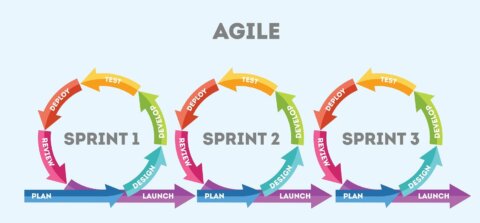The Art of Agile and Scrum
The Agile Framework is a “quality by design” approach to software development (and increasingly, to other types of projects) that emphasizes flexibility, collaboration, and iterative progress. It aims to deliver value to customers more quickly and efficiently than traditional project management methodologies.

Key characteristics of Agile include:
- Iterative and Incremental Development vs. Waterfall : Agile projects are broken down into small increments or iterations, with each iteration delivering a potentially shippable product increment. This allows for feedback to be incorporated early and often, leading to continuous improvement.
- Customer Collaboration: Agile encourages close collaboration with customers or stakeholders throughout the development process. This helps ensure that the product meets their needs and expectations.
- Adaptive Planning: Agile embraces change and uncertainty, with plans and requirements evolving as the project progresses. Rather than trying to predict every detail upfront, Agile teams focus on responding to change and delivering value incrementally.
- Cross-Functional Teams: Agile teams are typically small, self-organizing, and cross-functional, meaning they include members with a variety of skills necessary to deliver the product. This promotes collaboration and allows teams to be more responsive to changing requirements.
- Continuous Improvement: Agile promotes a culture of continuous improvement, with regular reflection and adaptation to improve processes, products, and team performance.
Popular Agile frameworks include Scrum, Kanban, Extreme Programming (XP), Lean, and others. These frameworks provide specific methodologies and practices for implementing Agile principles in different contexts, tailored to the needs of individual teams and organizations.
What is a Scrum Master?
A Scrum Master is a key role in the Agile framework known as Scrum. The Scrum Master is responsible for facilitating the Scrum process and ensuring that the Scrum team adheres to the principles and practices of Scrum. They serve as servant leaders to the team, helping them understand and implement Scrum practices effectively. The term scrum comes from the sport of rugby. The picture above is a scrum. One team is working together against the competitor. Scrum means working together instead of one at a time.
Key responsibilities of a Scrum Master include:
- Facilitating Scrum Events: The Scrum Master facilitates events such as Sprint Planning, Daily Stand-ups, Sprint Reviews, and Retrospectives, ensuring that they are productive and focused.
- Removing Obstacles: They work to remove any impediments or obstacles that may hinder the progress of the team. This could involve anything from resolving conflicts within the team to interfacing with external stakeholders.
- Coaching and Mentoring: The Scrum Master coaches the team on Agile principles and practices, helping them to continuously improve their processes and deliver value to the customer.
- Protecting the Team: They shield the team from external interference, allowing them to focus on delivering high-quality work during each sprint.
- Promoting Self-Organization: The Scrum Master encourages self-organization within the team, empowering team members to take ownership of their work and make decisions collaboratively.
- Fostering Collaboration: They promote collaboration and communication within the team and with stakeholders, ensuring that everyone is aligned towards common goals.
Overall, the Scrum Master plays a crucial role in ensuring that the Scrum team is functioning effectively, continuously improving, and delivering value to the customer in a timely manner.
Typical Scrum Master Training Outline
Introduction to Scrum
– Understanding Agile Principles
– Evolution of Scrum
– Scrum Framework Overview
– Roles and Responsibilities in Scrum
Scrum Master Role
– Responsibilities of a Scrum Master
– Characteristics of an Effective Scrum Master
– Servant Leadership in Scrum
Scrum Events
– Sprint Planning
– Daily Scrum
– Sprint Review
– Sprint Retrospective
– Backlog Refinement
Scrum Artifacts
– Product Backlog
– Sprint Backlog
– Increment
– Definition of Done
Facilitation and Coaching
– Techniques for Facilitating Scrum Events
– Coaching the Development Team, Product Owner, and Organization
– Conflict Resolution in Scrum
Agile Estimation and Planning
– Relative Estimation Techniques (e.g., Planning Poker)
– Release Planning
– Sprint Planning Techniques
Monitoring Progress and Metrics
– Burndown Charts
– Velocity
– Sprint Burnup Charts
– Cumulative Flow Diagrams
Scaling Scrum
– Scrum of Scrums
– Nexus Framework
– LeSS (Large Scale Scrum)
– SAFe (Scaled Agile Framework)
Agile Tools and Techniques
– Introduction to Agile Project Management Tools
– Kanban Boards
– Task Boards
– Agile Project Management Software
Continuous Improvement
– Kaizen Principles in Scrum
– Retrospective Techniques
– Implementing Feedback Loops
Scrum in Practice
– Case Studies and Real-Life Examples
– Hands-on Exercises and Simulations
– Best Practices and Pitfalls to Avoid
Certification Preparation
– Overview of Scrum Master Certification Exams
– Test-taking Strategies
– Sample Questions and Mock Exams
Conclusion
– Recap of Key Learnings
– Next Steps in Your Scrum Master Journey
– Resources for Further Learning
This outline covers a comprehensive journey through the Scrum Master role, providing participants with the knowledge, skills, and tools necessary to effectively lead and facilitate Agile projects using Scrum methodologies.







